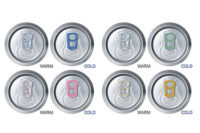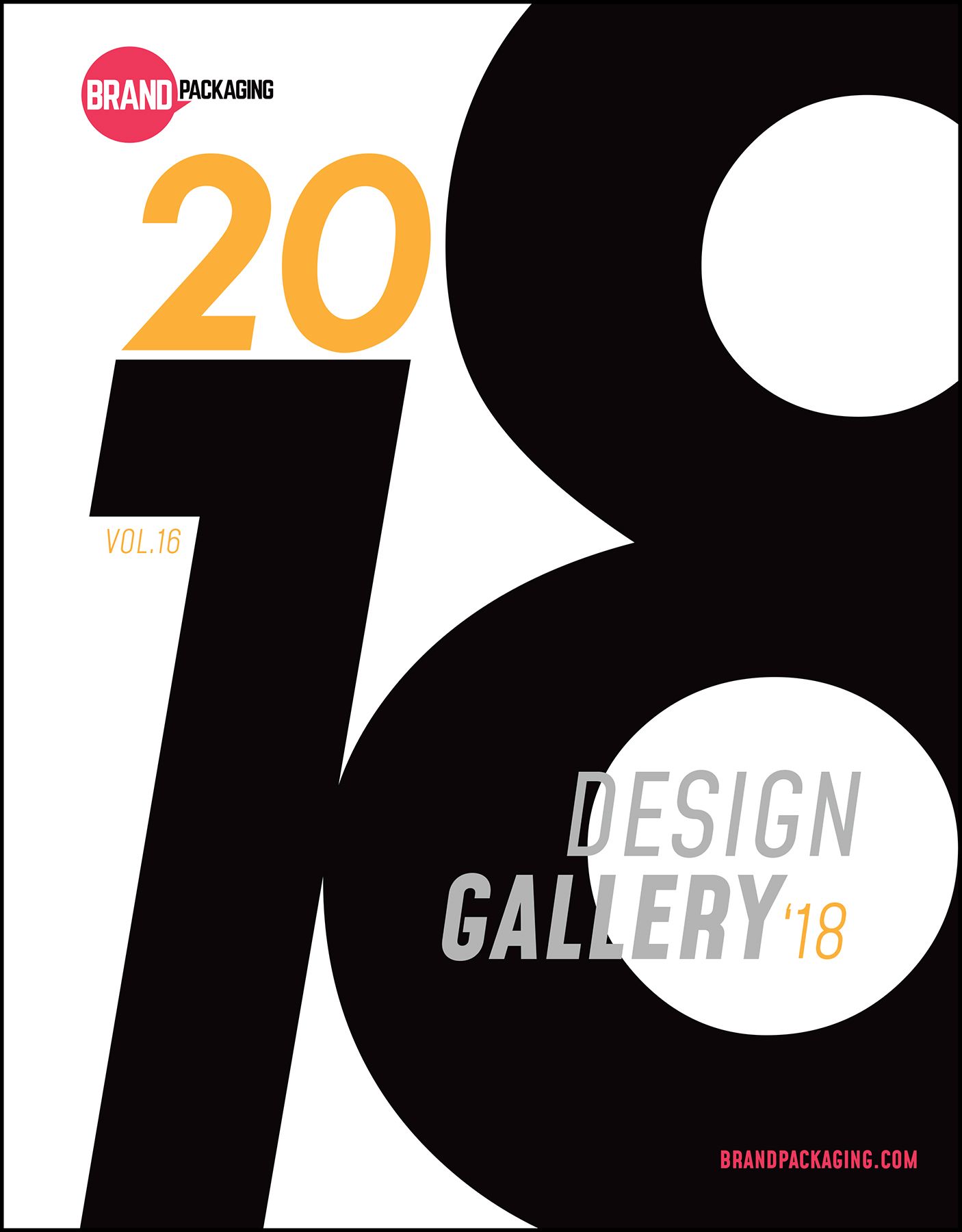Shelf Differentiation Through Labeling
By Annie-Marie Kennedy
Beverage brands use shrink and stretch labels to stand out
Graphics, color, bottle
shape, unique labeling and environmentally friendly packaging — all
of these factors will play a critical role for beverage companies in 2008
as they bring their products to market and compete for consumer attention.
Shrink and stretch labeling continues to be one of the most sought-after
labeling solutions for on-shelf differentiation, and as the technology
develops, this next generation of packaging is seeing improved cost
effectiveness, functionality and sustainability.
“The beverage market was an early adopter of
shrink sleeves and has continued to embrace shrink labels to achieve
on-shelf differentiation through the use of shape and color,” says
Gwen Chapdelaine, marketing director for Fort Dearborn Co., Elk Grove
Village, Ill.
Brian Metzger, director of business development for
SleeveCo, Dawsonville, Ga., agrees. “Perhaps the most interesting
trend is the growing utilization of shrink sleeve labels for private label
beverages,” he says. “Shrink sleeve labels are becoming the
great equalizer between national and private label brands.”
“The market is growing, and growing in areas
that we would not have seen in the past,” adds Ed Farley, sales
manager for Axon, a division of Pro Mach, Raleigh, N.C. “The process
has become faster and more affordable, and customers who would not have
considered shrink sleeving for their products because it was too
cost-prohibitive, are now able to reap the benefits.”
Those benefits include an increased consumer awareness
and shelf presence as more companies fight to keep up with trends that
offer custom-molded bottles and premium labeling for their products.
“A major factor in creating brand awareness is
to have a uniquely shaped bottle,” explains Amy Brown, marketing
manager for Overnight Labels Inc., Deer Park, N.Y. “The labeling
solution to accommodate those uniquely shaped bottles is shrink sleeves.
With shrink, a company can maintain brand identity by building a virtual
billboard around their product. Their options increase tenfold — what
the product can look like in terms of shape and overall aesthetic.
We’re talking 360-degree graphic ability.”
Improved production
While customers prefer the high-quality look of shrink
sleeve printing, traditionally, the overall cost of design and production
has been prohibitive. However, advances in application equipment are
helping drive down the total applied cost for these newer methods,
including pressure-sensitive, stretch and shrink labels, and suppliers say
more of their customers are requesting cost models to evaluate label
technologies.
To keep up with the speed of innovation, Alcoa
Flexible Packaging, Richmond, Va., recently installed a wide web W&H
flexo press at its Downingtown, Pa., packaging plant. This high-speed,
quick changeover press allows Alcoa to offer lower-priced labels, even at
small volumes. It also allows customers to make more frequent copy changes
(for example, for special promotional packaging) due to lower front-end
plate costs.
“Digital printing offers speed-to-market as well
as a platform for prototyping, sales samples and small-volume production
runs,” Fort Dearborn’s Chapdelaine adds. “UV flexo
printing approaches gravure quality (more opaque whites and gravure-like
metallics) for medium-volume production runs. There has also been a lot of
activity with shrink sleeves for merchandising purposes: multi-packs,
on-packs and promotional full-body shrink sleeves for regional, seasonal or
sporting events.”
Farley says Axon’s customers also have seen the
cost-saving benefits of faster production technology.
“We’ve been able to provide machinery that
is capable of providing labels at speeds our customers look for,” he
says. Axon’s Ez-Seal 400SL is a heat shrinkable sleeve labeling
system that provides high-production rates for
full-body and tamper-evident banding applications, capable of 400 packages
per minute. Its 2-400 SL is a dual-sleeve applicator, capable of 800
packages per minute, which translates nicely for soft drink customers.
“They are both affordable machines that fit
their speed needs,” Farley says. “Particularly with
international customers, this allows them affordable equipment to do short
label runs for special promotions or limited-time holiday packaging, for
example, and remain competitive in their speed-to-market turnaround
time.”
With so many innovations in premium shrink sleeve
packaging technology making it more widely available to beverage companies,
suppliers say interest also is growing in more sophisticated inks and
films.
To answer the call for more challenging graphics and
colors, the Seal-It division of Printpack, Farmingdale, N.Y., SleeveCo and
Fort Dearborn all offer a wide range of specialty inks to their beverage
clients. The lines include metallics, fluorescent glow-in-the-dark for
trendy beverages, thermochromatic inks that indicate hot or cold
temperatures, holographic inks for premium beverages, raised tactile inks
to highlight logos or special features, and even scented inks.
“These inks and coatings provide shelf appeal as
well as economical ways to achieve looks via printed labels only previously
possible through more expensive processes such as etched glass,”
Chapdelaine says. “Commercial applications developed specifically for
the beverage markets include high-coverage metallics, frosted, pearlescent
and acid-etched finishes in water-based flexo and gravure printing.”
More companies are seeking shrink innovations to not
only create high-impact shelf appeal, but are looking to add functionality
and extend product life. Films that increase barrier and insulating
properties top the list.
For example, f'REAL Foods, Orinda, Calif., chose Fort
Dearborn as its supplier partner to switch from preprinted cups to shrink
sleeve cups for its frozen dairy products. The packaging has since been
implemented on the company’s egg nog, milkshakes, smoothies and
cappuccino products. Fort Dearborn developed a custom freezer-grade
adhesive to ensure tack during the shrink tunnel application and to
maintain a strong sleeve-to-container bond from freezer environment through
consumer consumption. The milkshake’s
label utilizes metallic inks to simulate the look of a stainless steel cup.
Additionally, Alcoa is offering new Conceal barrier
labels, which block 100 percent of UV light and up to 99 percent of visible
light. Trials of the Conceal barrier labels are underway with some of the
company’s major beverage customers. The company anticipates seeing
the new patented Conceal labels on store shelves to help extend the flavor
and shelf life of beverages, in the coming months.
Green labeling
It should be no surprise that the fastest-growing
trend by far remains the development of greener packaging through the use
of sustainable materials, earth-friendly inks and the continued development
of greener production. As consumers continue to become more aware of and
push for green products, beverage companies are striving to reduce their
global footprint with environmentally responsible practices.
“Effects of packaging on the environment have
become an important issue to both industry and consumers,”
Chapdelaine says. “Initiatives are currently being driven by
Wal-Mart/Sam's Club and Target for ‘cradle to grave’
sustainable packaging. Consumer awareness of sustainable packaging is also
increasing as they are starting to equate environmentally friendly products
with their packaging.”
Fort Dearborn has developed a number of sustainable
product options, including recycled C1S paper, recycled wet-strength C1S
paper, and the development of water-based and UV flexo printing for shrink
sleeves to supplement solvent gravure.
Hammer Packaging, Rochester, N.Y., has boosted its
green quotient within the past year by installing a Drent-Goebel web offset
press, the first of its kind in North America. This innovative press offers
electron beam (EB) inks and coatings in addition to UV to allow Hammer to
provide greater options for presenting the customer’s brand image.
“We see it as our gravure replacement strategy, with the added
advantage of being more environmentally friendly,” says Doug Wegman,
Hammer’s marketing manager. “EB and UV inks do not emit
volatile organic compounds making them a more sustainable option.”
Hammer invested in downstream finishing technology,
which includes a continuous-operation KOR slitter. Additionally,
Hammer’s Karlville seamer is able to produce a certificate of
compliance for every finished roll. This combination turned out to be a
perfect solution for Bolthouse, a national juice producer.
“We are also seeing an increase in mono-web
films for roll-to-roll labels. Our EB coatings do not require lamination,
and this reduces a step in the printing process and potentially reduces
costs,” Wegman adds.
Most suppliers are offering their clients
environmentally friendly options like PLA films, which, since they are made
from corn-based materials, are 100 percent compostable, which makes it more
appealing than traditional petroleum-based films. Shrink sleeves also are
being printed on PETG and oriented polystyrene (OPS) which are considered
more environmentally friendly due to their superior recylability.
Inks are playing a role in earth-friendly processes as
well. “As a flexographic printer, we have the option of using
water-based inks for printing and that’s exactly what we’ve
done,” Brown says. “This means that the inks are
environmentally safe and hold no threat of solvent retention or
migration.”
A recent EPA case study found that a company that
switched to water-based inks showed a significant reduction in volatile
organic compounds, which helped eliminate hazardous waste from waste ink
and cleaning operations.
Overnight Labels anticipates the arrival of new
equipment within the month that will allow them to separate the water in
the ink from the colored pigments, which can then be recycled. “Since
water-based inks can be recycled, it means a reduction of total generated
waste,” Brown says. “The bottom line is that shrink materials
are improving in terms of shrinkage and environmental friendliness. In
addition, the processes used to produce these products are becoming
increasingly more important to both the manufacturer and consumer.”
Seal-It recently commercialized one of the first
full-body labels made from Earthfirst PLA film. It is being used to
decorate a glass bottle for a nutraceutical beverage produced by AgroLabs.
“Its exceptional shrink-ability, up to 75
percent, allows the film to fit to the contours of the glass bottle, and
the glossiness of the film allows for excellent printing and terrific
graphics,” says Barbara Drillings Seal-It’s marketing manager.
“Like other consumer packaged goods companies,
beverage manufacturers are coming to us, looking for ideas about how to
reduce their packaging footprint,” she says. “One-full body
shrink sleeve label could include graphics, nutritional information, bar
codes and even background information on the product, serving as an
effective replacement for multiple pressure sensitive labels. And recently
we’ve been getting requests for full sleeve labels with
tamper-evidence, an all-in-one label that can replace two
pressure-sensitive labels and a tamper-evident band. This helps reduce the
amount of packaging used, which has been an important requirement recently
for retailers.”
MRI Flexible Packaging, Newtown, Pa., cites its new
enhanced stretch labels as its latest innovation. Designed for recycling,
these stretch labels tear away easily from the beverage bottle, making it
easy for the consumer to prepare the PET bottle for the recycling bin.
“Because the labels are applied in a one-step
process, with no glue or heat tunnel necessary, there is a lower energy use
on production lines,” says Jim Mallon, MRI Flexible Packaging’s
vice president of sales and marketing. “In addition, these stretch
sleeves use less material per square inch vs. shrink or roll-on-shrink-on.
Ultimately that translates to less material entering the recycling
stream.”
Innovations in shrink and stretch technology will
continue to push the industry forward, as beverage companies invent new
ways to establish a memorable brand identity.
“The market will continue to grow,” Farley
says. “Label pricing for shrink has gone down over the years ...
As long as the beverage industry continues to come up with shapely bottles
and creative packaging to make their product stand out, shrink will remain
the best method to accomplish that.”



